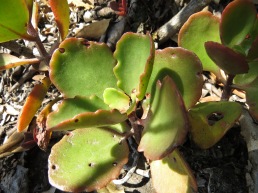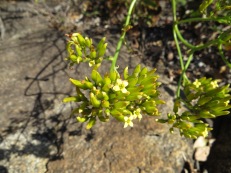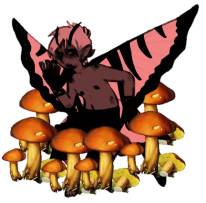 Yesterday I went for a scramble to a rocky outcrop below the deck of our house towards our northern boundary. This is where we often see our family of Klipspringers, and there, in amongst the rocks was a flattened grassy area where they have probably been sleeping. But your blog title is “HeatherTon Wildflowers”, why are you writing about small antelopes? You may ask… Well I just couldn’t resist telling you that we regularly see these dainty antelope at HeatherTon! Now back to the Kalanchoe that I found.
Yesterday I went for a scramble to a rocky outcrop below the deck of our house towards our northern boundary. This is where we often see our family of Klipspringers, and there, in amongst the rocks was a flattened grassy area where they have probably been sleeping. But your blog title is “HeatherTon Wildflowers”, why are you writing about small antelopes? You may ask… Well I just couldn’t resist telling you that we regularly see these dainty antelope at HeatherTon! Now back to the Kalanchoe that I found.
 The common name, Hasieoor translated would be Rabbit Ear, I suppose, but what is so attractive about these plants growing on a large rounded granite expanse (We call Baboon Rock)? Would it be the panicle of bright yellow flowers so vivid against a pale blue autumn sky or the thick fleshy succulent leaves tinged with red? Succulents have a special place in my heart as my late mother was an avid succulent collector and it reminds me of many happy hours scrambling around in the poort at Schaffhausen (my grandfather’s farm near Cathcart in the Eastern Cape) looking for different plant species to add to her extensive collection.
The common name, Hasieoor translated would be Rabbit Ear, I suppose, but what is so attractive about these plants growing on a large rounded granite expanse (We call Baboon Rock)? Would it be the panicle of bright yellow flowers so vivid against a pale blue autumn sky or the thick fleshy succulent leaves tinged with red? Succulents have a special place in my heart as my late mother was an avid succulent collector and it reminds me of many happy hours scrambling around in the poort at Schaffhausen (my grandfather’s farm near Cathcart in the Eastern Cape) looking for different plant species to add to her extensive collection.
The Kalanchoe genus has 13 recognised species growing in South Africa and Kalanchoe is the “Latinised form” from the Chinese name “kalan chauhuy’” which is thought to mean: “that which falls and grows”. The species name paniculata means: with a branched racemose or cymose inflorescence (panicle). World wide there are more than 125 species which form part of the family Crassulaceae which means: thick fleshy leaves – an apt description of the plants in this family.
 The plant is somewhat woody and has robust stems with opposite, paddle-shaped, pale green fleshy leaves. The irregularly lobed margins are tinged with red. The leaves at the base of the plant are about 70mm long by 35mm wide.
The plant is somewhat woody and has robust stems with opposite, paddle-shaped, pale green fleshy leaves. The irregularly lobed margins are tinged with red. The leaves at the base of the plant are about 70mm long by 35mm wide.
 The flower panicle is borne on a long stem about 500mm long and is flat topped. Each bright yellow floret consists of 4 petals joined to an urn-shaped tube. I initially thought this was a Crassula (genus) as well, but further research has indicated that although it is in the Crassula family, Kalanchoes have 4 petals and the Crassula genus have 5 petals.
The flower panicle is borne on a long stem about 500mm long and is flat topped. Each bright yellow floret consists of 4 petals joined to an urn-shaped tube. I initially thought this was a Crassula (genus) as well, but further research has indicated that although it is in the Crassula family, Kalanchoes have 4 petals and the Crassula genus have 5 petals.
A little whimsy – Teasel Yewnest
 He casts spells of enchantment. He lives in mushroom fields and quiet meadows. He can only be seen when the sun sets on the day of a completed harvest. He wears spiky seed pods and has russet-coloured wings like a brightly coloured butterfly.
He casts spells of enchantment. He lives in mushroom fields and quiet meadows. He can only be seen when the sun sets on the day of a completed harvest. He wears spiky seed pods and has russet-coloured wings like a brightly coloured butterfly.











You must be logged in to post a comment.